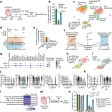STRUCTURAL AND FUNCTIONAL STUDIES OF HER RECEPTOR TYROSINE KINASES
Abstract Text:
DESCRIPTION (provided by applicant): The long-term goals of this project are to develop a molecular and structural understanding of the fundamental mechanisms that control activation and signaling by human epidermal growth factor receptors (HERs). HER receptor tyrosine kinases, EGFR, HER2, HER3 and HER4 play pivotal roles in controlling cellular growth, survival and motility. Misregulation of these receptors is common in different types of cancer, neuropathological disorders and cardiovascular diseases. While significant progress has been made in identifying drugs that target EGFR and HER2 over the past decade, the development of resistance mediated by the HER3 receptor is an emerging problem. HER3 is an unusual member of the HER family, because it is catalytically inactive. It can, however, dimerize with EGFR and HER2 resulting in the allosteric activation of their catalytic domains. HER3 is a challenging target for drug discovery because it lacks an enzymatically active site and we do not understand very well how HER3 interacts with EGFR and HER2. This application will address these issues by defining the molecular mechanism by which HER3 forms active signaling complexes with EGFR and HER2, and exploring this knowledge to develop HER3 inhibitors. The central hypotheses are that allosteric function of HER3 can be modulated through its nucleotide-binding site, which is a hypothesis formulated based on our preliminary data, and that an understanding of the molecular underpinnings of HER3 heterodimerization with other HERs will reveal basic principles of HER3 allosteric function. The following specific aims will be investigated: 1. The mechanism by which nucleotide binding regulates allosteric function of HER3 will be studied to inform the generation of small molecules that inhibit HER3; 2. The structural basis for HER3 heterodimerization with EGFR and HER2 will be investigated to define the mechanism by which growth factor binding is structurally coupled to catalytic activation; 3. The contribution of HER3 heterodimerization to signaling by EGFR and HER2 in cells will be investigated using single molecule imaging. This approach is innovative because it addresses a novel functionality within HER3 and will define the unknown aspects of HER3 allosteric function towards other HER receptors. This work will also contribute to the development of novel experimental strategies designed to overcome the challenges associated with studying membrane receptors. The proposed research is significant because it adds a new regulatory step in the activation mechanism of the HER family of receptors. Moreover, the proposed research is expected to advance our molecular understanding of how HER receptors integrate external activating signals to result in tightly controlled activation of their intracellular enzymtic functions. Ultimately, this detailed understanding of HER3 functions will inform the development of next generation inhibitors that can help alleviate the increasing problem of resistance to agents that target HER receptors in human diseases.



